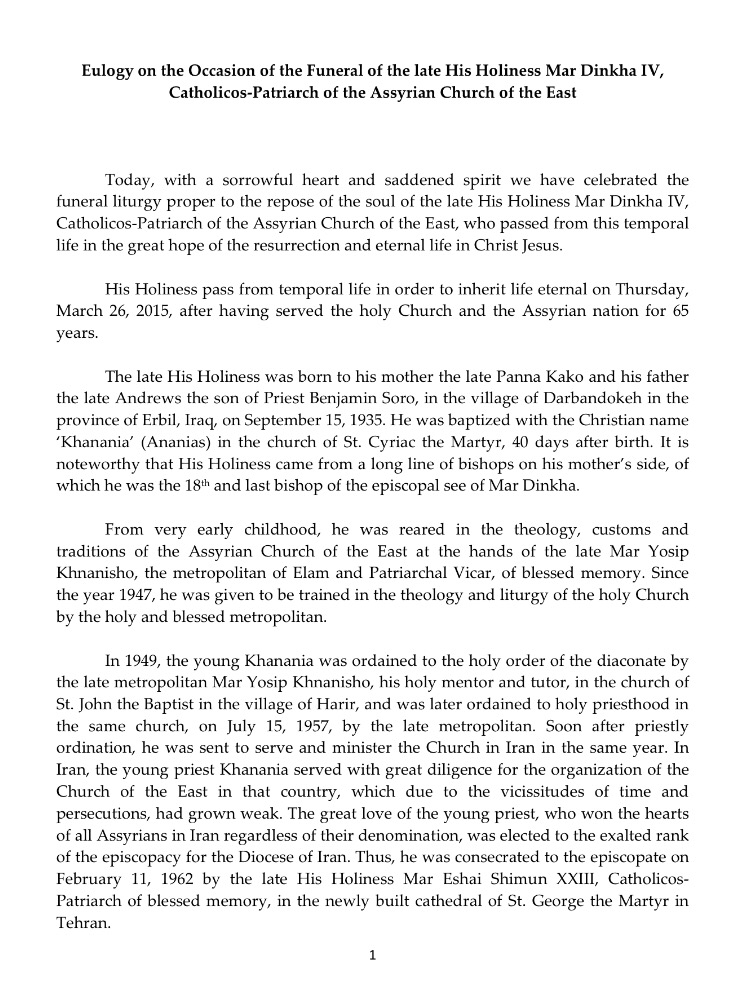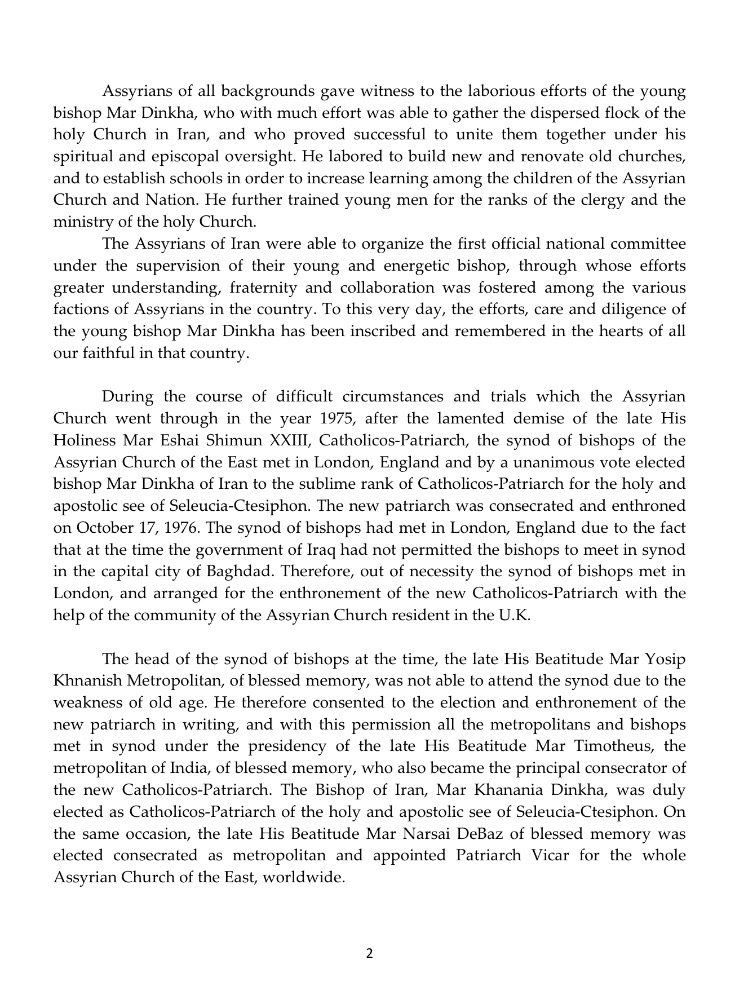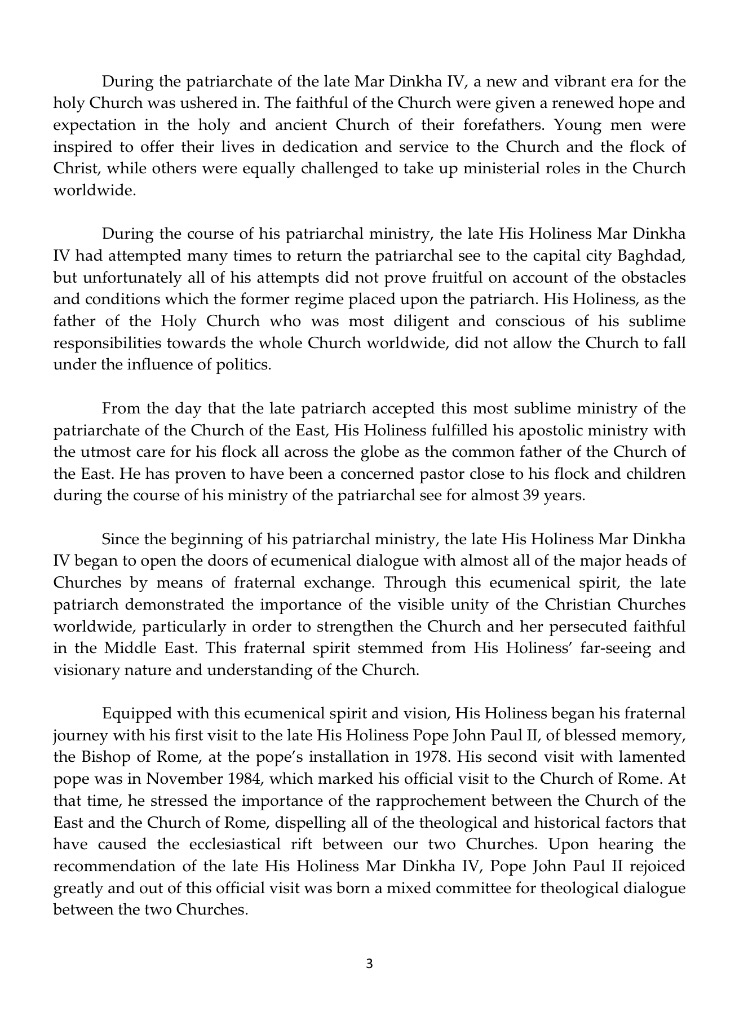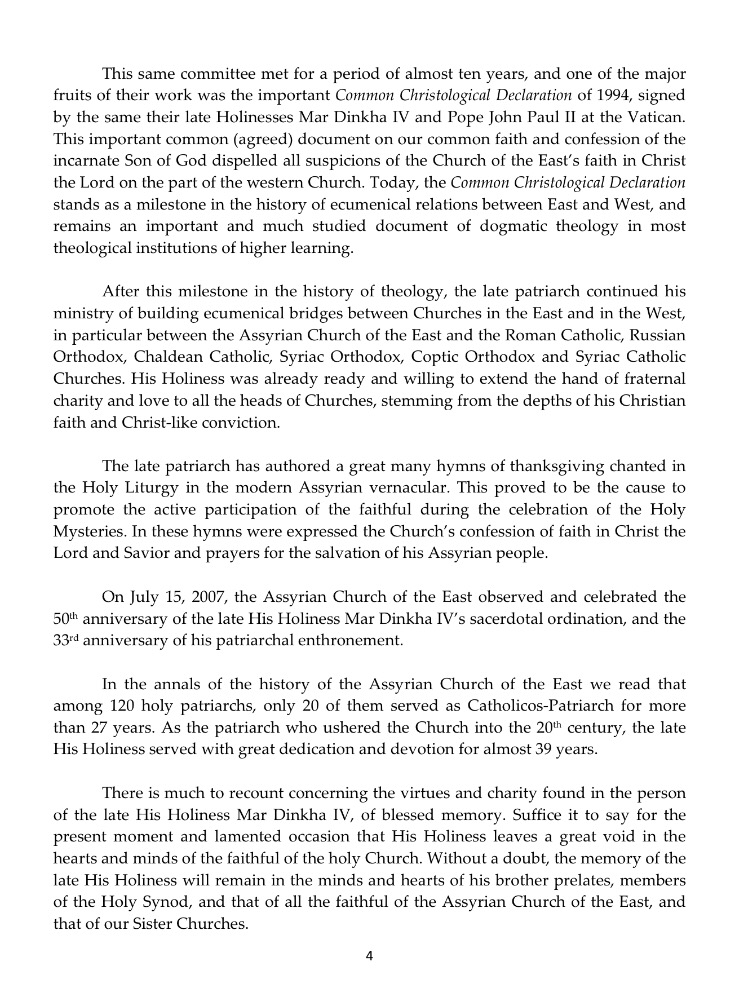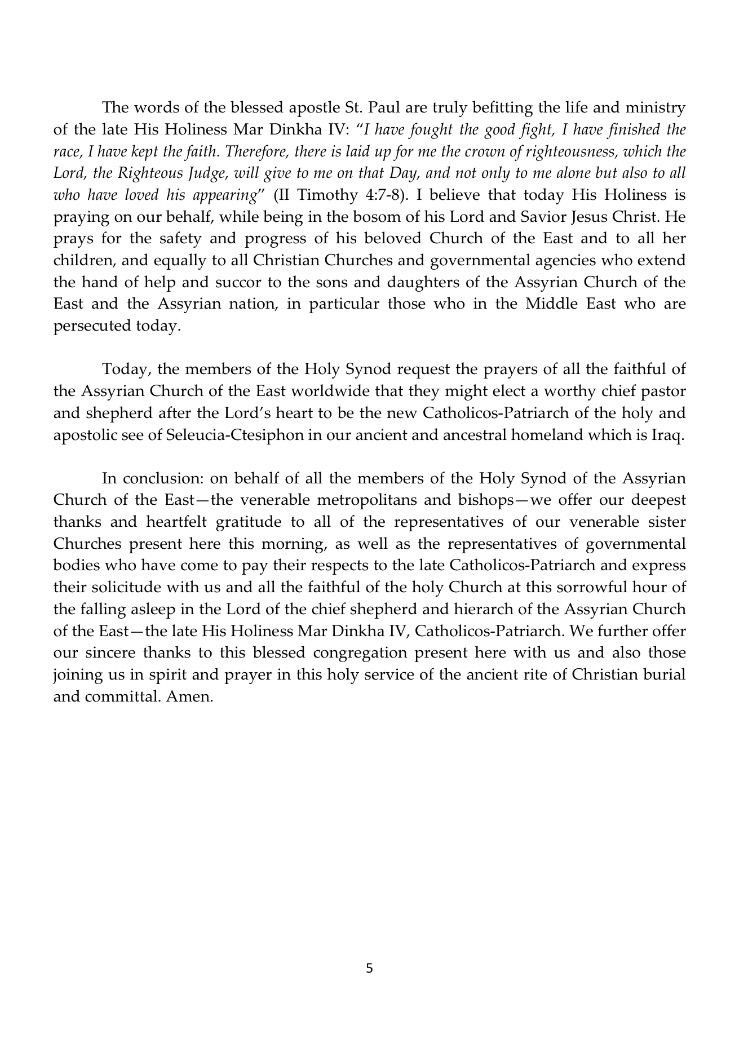The Biographical Sketch of The Holy Father Mar Dinkha IV Catholicos Patriarch of the East
The Father of Fathers of the Holy Apostolic Catholic (Assyrian) Church of the East,
presently is the 120th successor to the Holy Apostle Peter, the Chief of Apostles.
Introduction:Because His Holiness Mar Dinkha IV The Catholicos Patriarch is known among the
Eastern and Western Church, it is unnecessary for us to re-introduce The Holy
Father to us all. The love and the understanding exuding from the person of His
Holiness has made him, an individual of honor; and, to be received with all proper
integrity and honor, from among the various world, secular and religious
personalities.
The Prophecy of the Patriarchate:His Beatitude Mar Aprem Mooken the Patriarchal Representative and Metropolitan
of Malabar and all-India, as a young priest studying in a New York seminary, was
present at one of the festive celebrations which had been offered by the Parish of
Mar Mari in Yonkers, New York, in the year 1967, which was in honor of His
Grace Bishop Mar Dinkha as the Bishop of the Church of Iran. His Beatitude,
during the course of his speech, had expressed a wish, “that one day, His Grace
Mar Dinkha, would be the next Patriarch of the Church of the East.” The
consecration of The Catholicos Patriarch with nephew succeeding uncle had been
disbanded, therefore, by the decree of the late Catholicos Patriarch Mar +Eshai
Shimun XXIII, the succeeding patriarch and bishops within the Holy Synod will not
be elected from among certain families. The election of all the hierarchy will be
from among the faithful of The Holy Church. Mar Aprem of India declared in his
remarks “ . . let us place our hope that the next patriarch which we elect will be this young, wise and enlightened Bishop of Iran. The prophetic utterance of His
Beatitude was fulfilled and came to pass in the year 1976. This young Bishop of
Iran was elected to the Awesome Office of Catholicos Patriarch; and, consecrated
to occupy the widowed See of Selucia Ctestiphon.
In the year 1976, the widowed See of the Patriarchate of the Church of the East
summoned by the locum tenens Mar Timotheus of India to a Holy Synod in order to
elect a succeeding Patriarch. The Holy Synod was called to order by the venerable
and esteemed late Metropolitan Mar +Timotheus of India in London, England,
October 1976. At the time of the convening of the Holy Synod, and the request for
a nominee to be presented for consideration for an occupant of the widowed
Patriarchal See; the unanimous consent of the Metropolitans and Bishops present
fell upon the Venerable and Learned Bishop of Iran; Mar Dinkha.
With the exception of His Beatitude, of blessed memory, Mar +Yosip Khnanishou,
His Lordship Mar Dinkha of Iran was the only Bishop consecrated before the
untimely schism of 1964. The blessed elder Metropolitan Mar +Yosip of the
Church of Iraq was seriously ill and infirm; and unable to attend the Holy Synod of
1976. Under the hand of the Holy Spirit His Holiness Mar Dinkha IV was
consecrated and sat upon the Apostolic Throne of Selucia Ctestiphon.
From the very first day in which Mar Dinkha IV had been installed as The Chief
Shepherd of The Church of the East; he has untiringly and faithfully proceeded to
fulfill his ministry as the Universal Father of The Holy Church. This great
responsibility of His Holiness Mar Dinkha IV, did not prevent him from developing
a profound closeness to the faithful regardless of the lands in which they reside.
Let us mention here, that while His Holiness as The Bishop of Iran, did indeed,
make Apostolic Visits throughout The Church, meeting with the faithful in The
Church of India, the Church of Iraq, the Church of Lebanon, the Church of Europe,
the Church of Canada, the Church of Australia, and the Church of America, he did
enjoy the friendship of these precious believing faithful members of the Holy Flock
of our Lord.
His Holiness Mar Dinkha IV Catholicos Patriarch is privileged with a gift of
knowing a great number of the faithful in The Church. His unique ability to recall
those whom he had met always amazes the faithful, for he can call them by their
names. Therefore, as the story of the Holy Gospel relates: “ . . . the Good
Shepherd knows those who belong to Him, and He calls them by their names, and
they recognize his voice and they follow Him.” His Holiness is unique for he is
the only Patriarch known who is able to recall details of any family member, from
which region they had migrated, who their ancestry or forebears may be, etc. In
his rôle as the Supreme Head of The Holy Church, he has initiated and completed
many Apostolic Visits, bringing comfort, healing, encouragement, hope, inspiration
and strength to the scattered flock of The Church throughout the world.
His Holiness is very much aware of the his historical roots, both as to the Church of
the East; and, of his national ethnic origin; the ancient Assyrian history, the
language and the culture; always ready to address and speak in detail as to the
historical events in The Church and the Assyrian Nation. He has gained his
profound knowledge by investing his time in reading a great number of books
which presented a comprehensive study in these particular fields of interest. As to
his use in the languages of the world, His Holiness very comfortably communicates
with non-Assyrians. He is capable of speak to you using either English, Parsee,
Kurdish, or Arabic with ease.
In The Holy Synod of The Church, His Holiness demonstrates an equal fairness of
democratic practice, concerns and thoughts among the prelates. As it affects the
decisions which the Holy Synod will render; he will request of each prelate to
present his thoughts freely, and without fear. Thus we can state here, that in the
future, no prelate can say, or state, that he did not understand a particular point nor position presented to the Holy Synod. His Holiness Mar Dinkha IV, does not act
in haste! He is a thinker and is very thoughtful before any action is determined.
In the forthcoming generation it is of considerable importance for them (i.e.: the
younger generation) to know the rôle and the various achievements of this, our
Holy Father! His Holiness has been very active in the field of ecumenical dialogue
with other Sister Apostolic Churches and Christian bodies. It is through dialogue
that His Holiness has been enabled to rebuild and reestablish communication
between the Apostolic Churches, the Roman See in particular and other Christian
communities. It was through dialogue His Holiness was able to make known to all
Christian Communities that The Church of the East confesses the Apostolic and
Orthodox Faith. In November of 1994, the Common Christological Declaration
was signed between The Roman See (His Holiness John Paul II of Rome), and that
of The Church of the East (His Holiness Mar Dinkha IV), in which the obstacles of
misunderstanding and separation was removed following 1500 years of a sad
division. A Mixed Committee was established for further exploration in the matter
of dogma. The Mixed Committee has, after a ten year study, discussion etc.,
produced a document on “The Sacramental Life” of the two Churches. It is now
ready to be signed, by the hierarchs of the two churches.
His Holiness is concerned about the future generations which will succeed us, who
are the older generation. His concern is centered in the need to develop
educational programs for the children and the youth. He is a great lover of the
Church Choir, and he has developed certain hymns which are appropriate for use in
the Holy Mass throughout a given year. Wherever the faithful of The Church may
be located, he is eager to appoint a priest and clergy to serve them, in order to build a church and a place of common gathering, so that they will not be deprived of the Sacramental Life.
Unfortunately, in 1964, a schism developed in The Church of India. Since His
Holiness had ascended/succeeded to the Throne of Selucia Ctestiphon, he has been
successful in leading The Church to reunite with the Apostolic See, thus bringing
healing to the body of believers.
His Holiness thinks and thought much about the necessity of having an educated
clergy, as we entered into the Third Millennium. To achieve this intent and goal,
His Holiness established a seminary in the Church of Iraq. His Holiness has sent
our clergy following their educational program in our Iraqi seminary, to the
institutions of higher learning in Rome, and elsewhere, to complete their
philosophical and theological studies, and now, thanks be to God, we have a
number of clergy who are capable of leading the younger generation into an
awareness of the profound spiritual truths of The Church of the East; its Third
Millennium. (The result of his insights.)
The birth and upbringing of His Holiness:The great-grandfather of His Holiness, the late and of beloved memory The Rev’d
Fr. Soro was known throughout the Holy Church of the East for his spirituality and
Christlike humility and piety. He lived in righteousness, adorning his behavior
with fasting and perpetual prayer, his life’s span was over 100 years on this earth.
He was born in the year of 1856, in Nochia (in the region of the mountains of
Hakkari), and rested in peace in 1961 in the Village of Durbandoke in Northern
Iraq. This blessed priest of our Lord and God was from the House of Mar Dinkha,
The Bishop of Urmia, Persia, who had received the crown of martyrdom, together
with forty (40) Assyrian Christian men in the year 1915, on the top of the hill called “The Hill of the Jews” behind the Village of Charbash, in the Provence of Urmia, Persia. This Bishop was the last bishop of the See of Mar Dinkha, till the
consecration and arrival of Mar Khanania Dinkha in the year 1962. The late and blessed +Andrious, the son of the Rev’d Fr +Benjamin, the issue of the
late Rev’d Fr. Soro, took to himself a wife, of blessed memory, the late +Pana,
the daughter of blessed memory Kako. The beloved Pana, was greatly respected
by all who were aware of her simple trusting and great faith. Andrious and Pana
lived together in the Village of Durbandoke, the Parish Mar Quriakos, in the region
of Harrier. Mar Dinkha was born to his parents, 15 September 1935, in the Village
of Durbandoke. He was subsequently baptized and confirmed in the Holy Faith by
his grandfather, The Rev’d Fr. Benjamin, in the village Church of Mar Quriakos.
His Holiness was reared in the Diocese of Arbil, where many great leaders of the
Church of the East were born and reared, such as Mar Odeshoo and Mar Qardaq.
His Holiness had been reared as a Nazarite from the moment of his conception; and,
thence offered as a lamb to serve The Holy Church, even before his birth. Thus his
beloved mother +Pana, when Khanania was being carried in the secret parts, lived
in piety, and free from the consumption of flesh meats, etc. She was always
engaged in fasting and prayer, till the day of his birth. Khanania lived a Nazarite
vow, according to the ritual of the Nazaritic practice; like the Old Testament
prophets, Elijah, Elisha, and John the Baptist. He did not drink strong drink, and
his food was of the earth, fruits, nuts and vegetarian. Following the birth of
Khanania, another son was born to this blessed family unit, they named him Ezaria
at his baptism. Again God further blessed this pious couple with a beautiful
daughter, whom they had named Virginia at her baptism. Pana passed into the
Eternal Presence of our Lord, in Tehran, 1968; and Andrious entered into life
eternal in San Jose, USA, in 1999. Presently the Honorable Ezaria is serving the
Holy Church as Deacon, in the Cathedral Parish of Mar Yosip Khananisho, San
Jose, California.
His Holiness obtained his knowledge of the worship of the Holy Church; which
includes the Liturgy, Language, Faith Tradition, etc., from his forebearers, the late
Rev’d Fr +Benjamin. In 1947, at the age of 12 he was entrusted to the blessed
hands of the late Metropolitan the blessed Mar +Yosip Khananisho. From that
time forward, Mar +Yosip became the spiritual guide and teacher to His Holiness.
When the late Rev’d Fr. Benjamin, held the hand of young Khanania, and in turn
offered him to His Beatitude, saying: “. . Your Beatitude, I am now offering to you
this young lamb, you rear him as you know and wish, to do, in order to work for
The Holy Church. Thus from this moment forward, he does not belong to us, he
belongs to The Holy Church.”
With two years of intensive training and teaching by His Beatitude Mar +Yosip,
Khanania was ready to be ordered into the Sacred Diaconate. 12 September 1949
he was set aside to the Sacred Office through the Apostolic Laying on of Hands, by
his mentor, Mar +Yosip. During this time, as he served as Deacon and assistant to
His Beatitude, he continued to unceasingly study the Aramaic Language, the
Theology of The Church and her Sacred Liturgy. At the conclusion of 8 years of
intensive studies, His Beatitude Mar +Yosip, commended Shammasha Khanania, to
be elevated to the Sacred Office of Priest of God. 15th July 1957, at the
Commemoration of Mar Koriakous, His Beatitude Mar +Yosip laid hands upon
Shammasha Khanania and set him aside into the Sacred Office Priest. During
World War II, The Holy Church lost a great number of clergy. The Holy Church
began to give evidence of considerable weakness owing to the lack, and simple fact,
that the Reverend Clergy had been reduced in great number. It was His Beatitude
Mar +Yosip who had realized the great distress and profound need for clergy in The
Holy Church. This is the reason that he had accepted the young Khanania, and
trained and ordained, and gave to him a greater mission; which was to go to Iran
and the widowed Church of that land.
A bishop was greatly needed for the Church of Iran! In order to fill this need His
Beatitude Mar +Yosip consecrated the Rev’d Pilipos as Mar Youkhana, Bishop for
Urmia, and all-Iran; but unfortunately, owing to the political difficulties between
Iraq and Iran, an entrance visa was not granted to this new bishop for the Church of
Iran. For this reason, Mar Youkhana remained in the City of Dianna, and served
there as Bishop for the regional Diocese of Arbil and Kirkuk. As the political
scene improved between Iran and Iraq, and in order for His Beatitude Mar +Yosip
to fill the vacancy to The Church of Iran, he sent The Rev’d Khanania to Iran.
Thus, step by step Mar +Yosip prepared him for the Holy Episcopacy. When no
priest was available in the Church of Iran, in 1939, Mr. Ruel Arsinis went down to
India, and was ordained Deacon and then to the Priesthood for the Church of Iran,
by the Apostolic Laying-on-of-Hands by His Beatitude, of late blessed memory
Mar +Awimalk Timotheus, the Metropolitan of India. This priest (Qashisha
Arsinis), served The Holy Church of Iran for a long period of time, faithfully. The
Rev’d Fr Khanania arrived in Abadan, Iran, December 25th 1957. He joyfully
served The Kurbana Kaddisha for the faithful in Abadan, January 7th 1958,
Christmas Day, according to the Old Calendar. Fr Khanania labored untiringly in
the field of service for the greater glory of our Lord Jesus Christ in what appeared
to be an abandoned (but, widowed) Church of Iran. In Tehran, he had erected the
beautiful Cathedral Church of St George the Martyr, and again, he labored toward
the building of a parochial School in Tehran. Many things were set in order in
Tehran by the young priest Fr Khanania. People were very happy and truly
grateful for this young industrious priest who was but 23 years of age. Fr.
Khanania was officially appointed as the representative of the Metopolitan, for the
whole of The Church of Iran.
Toward the completion of the Church of St George the Martyr, Tehran, His
Holiness of blessed memory, Mar +Eshai Shimun XXIII visited The Church of
Iran, and consecrated the new Church, 9th February 1962. With the helping hand
of our worshipful God, and the untiring labors of The Rev’d Fr Khanania, The
Church of the East, for the first time had erected an edifice to worship God in the
City of Tehran. By the majority of the faithful sons and daughters of The Church
of Iran, a petition was presented to His Holiness of blessed memory Mar +Eshai
Shimun XXIII to consecrate The Rev’d priest Fr Khanania as Bishop for The
Church of Iran. The petition was accepted, and on the 11th of February 1962, The
Rev’d Fr Khanania was elevated and consecrated Bishop for the Church of Iran,
taking the name Mar Dinkha. His Lordship Mar Dinkha, as Bishop, built The
Parish Church of St Mary the Virgin in the City of Urmia; and, also another Parish
Church, bearing the Virgin Mother’s name: St Mary. As the faithful of The
Church witnessed the outcome of his intensive labors, they stood behind him in full
support in all steps which he took, for the progress and success of The Holy Church
of Iran.
His Beatitude Mar +Yosip in his congratulatory epistle to Mar Dinkha the newly
consecrated Bishop of Iran, wrote and said: “ . . . in one meeting with Mar +Eshai
Shimun, in Tehran, he ordained The Rev’d Khanania Bishop of Tehran and
all-Iran, we beseech our Lord and God to grant to him, physical and spiritual
health, wisdom, enlightenment of leadership, in order to lead the faithful flock
which had been entrusted to his spiritual paternity. His Beatitude is praying that
our worshipful God be with Bishop Mar Dinkha to watch over his flock, to ordain
priests and deacons which are needed for the ministry in the vineyard of Christ.”
The Metropolitan of late blessed memory Mar +Yosip, continues to write in the
form of a poem, stating: “. . . Our Lord and Savior Jesus Christ, who had come
down from Heaven, in wonder, and put on the humility of humanity, by the Power
of the Holy Spirit, from the blessed daughter of David, keep Thy servant His Holiness Mar Dinkha IV,and make him quiet and humble and a famous leader to watch over the flock with diligence, and in all love and joy: Amen ”
In 1966, His Lordship Mar Dinkha of Iran, visited The Church of America, and he
was well received and loved by the sons and daughters of The Holy Church. Then,
in 1967, His Lordship broke the ground and placed the corner-stone for the building
of the Mar Mari Church, Yonkers, New York. In February 1967, His Holiness
Mar +Eshai Shimun XXIII Catholicos Patriarch of the East, commissioned Mar
Dinkha of Iran accompanied by The Rev’d Fr. Isaac Rehana upon an Apostolic
Visit to The Church of India. Possessed with full confidence and certainty, Mar
+Eshai Shimun XXIII, knew that Mar Dinkha of Iran was the most capable prelate
in The Church to be sent for this particular mission, during a critical moment in our
history in The Church; at the time Mar Toma Darmo had been suspended (effective
10th January
Source: ACOE Global Youth Organization

